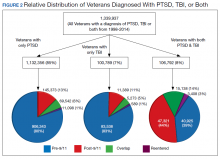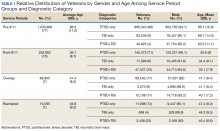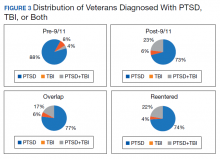Demographic Profile and Service-Connection Trends of Posttraumatic Stress Disorder and Traumatic Brain Injury in US Veterans Pre- and Post-9/11
Introduction: This study seeks to understand the demographic changes in the active-duty service member profile, both prior to and following September 11, 2001 (9/11). The study analyzed diagnosis of posttraumatic stress disorder (PTSD) and traumatic brain injury (TBI) and measures of severity of those diagnoses as recorded in service-connection ratings (percent disability).
Methods: A retrospective cohort-study of military veterans who received care at Veterans Health Administration medical centers between December 1998 and May 2014 was conducted based on clinical data recorded and stored within the Corporate Data Warehouse.
Results: A cohort of 1,339,937 veterans received an inpatient or outpatient diagnosis of PTSD and/or TBI. The cohort was divided into 4 service period groups and 3 diagnosis categories. The service periods included pre-9/11 (n = 1,030,806; 77%), post-9/11 (n = 204,083; 15%), overlap-9/11 (n = 89,953; 7%), and reentered post-9/11 (n = 15,095; 1%). The diagnosis categories included PTSD alone (n = 1,132,356; 85%), TBI alone (n = 100,789; 7%) and PTSD+TBI (n = 106,792; 8%). Results of the post-9/11 group revealed significant changes, including (1) increase of veterans with PTSD + TBI; (2) increase of female veterans with PTSD + TBI; and (3) increase of severity level of diagnosed PTSD/TBI as evidenced by higher service-connected disability pensions at younger age in the post-9/11 group. Additionally, data revealed unequal distribution of veterans with PTSD + TBI across geographic areas.
Conclusions: The veteran of the post-9/11 service period does not mirror the veteran of the pre-9/11 service period. Findings are valuable for policy making, allocation of resources, and for reconsidering the prevailing paradigm for treating veterans with PTSD and/or TBI.
Methods
This study was approved by the Kansas City VA Medical Center Institutional Review Board. VHA data from the Corporate Data Warehouse (CDW) and the National Patient Care Database were extracted using the VA Informatics and Computing Infrastructure (VINCI) workspace. CDW uses a unique identifier to identify veterans across treatment episodes at more than 1,400 VHA centers organized under 21 Veterans Integrated Service Networks (VISNs). These sources of VA data are widely used for retrospective longitudinal studies.
Study Population
The study population consisted of 1,339,937 veterans with a VA inpatient/outpatient diagnosis of PTSD or TBI using International Statistical Classification of Diseases and Related Health Problems, Ninth Revision (ICD-9) codes between December 1, 1998 and May 31, 2014. Demographic (gender classification, race, ethnicity, marital status, age at date of data extraction, and date of death if indicated), service-connection disability rating, and geographic distribution within VISN data on each veteran were then extracted.
Veterans in the cohort were assigned to 1 of 4 US military services period groups. The pre-9/11 group included veterans who entered and left the military prior to September 11, 2001. This group mostly included veterans from World War II, Korean War, Vietnam War, and the first Gulf War (1990-1991). The post-9/11 group included veterans who first entered military services after September 11, 2001. The overlap group included veterans who entered military services prior to 9/11, remained in service and left after September 11, 2001. The reentered group included veterans who entered and left service prior to September 11, 2001, and then reentered military service after September 11, 2001 (Figure 1). Using ICD-9 codes, veterans also were placed into the following categories: PTSD alone (ICD-9 309.81 only), TBI alone (ICD-9 850.0-859.9, V15.52), and PTSD+TBI (any combination of ICD-9 codes from the other categories).
Statistical Analysis
Descriptive statistics were applied using proportions and means. Relationships between variables were examined using χ2 tests, t tests, analysis of variance, and nonparametric tests. All hypotheses were 2-sided at 95% CI. Results are presented as absolute numbers.
Results
PTSD only (n = 1,132,356, 85%) was the predominant diagnosis category followed by PTSD+TBI (n = 106,792, 8%) and TBI only (n = 100,789, 7%) (Figure 2). Most of the veterans in the study served pre-9/11 (77%), followed by post-9/11 (15%); 7% were in the overlap group, and 1% in the reentered group (Table 1). It is notable that the proportion of veterans diagnosed with PTSD decreased from pre-9/11 (88%) to post-9/11 (71%), overlap (77%), and reentered (74%) service periods. Increases were noted in those with PTSD+TBI diagnosis category from pre-9/11 (4%) to post-9/11 (23%), overlap (17%), and reentered (22%) service periods (Figure 3). In general, the relative distribution of diagnostic categories in all the service periods showed a similar trend, with the majority of veterans diagnosed with PTSD only. Across all service periods, significantly smaller proportions of veterans were diagnosed with TBI only (P < .001).
Distribution by Gender and Age
The cohort was 92% male (n = 1,239,295), but there was a marked increase in the percentage of nonmale veterans in post-9/11 groups. Study population ages ranged from 18 to 99 years based on date of birth to the date data were obtained; or date of birth to date of death, for those who were reported deceased at the time the data were obtained. The average (SD) ages for veterans in the pre-9/11 group were significantly older (66.3 [11.2] years) compared with the ages of veterans in the post-9/11 group (36.1 [8.7] years), the overlap group (41.4 [8.2] years), and the reentered group (46.9 [9.2] years), respectively.










